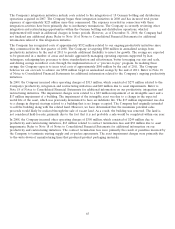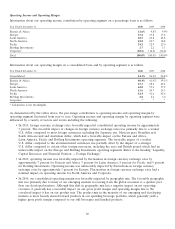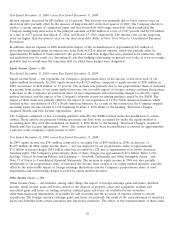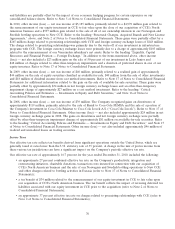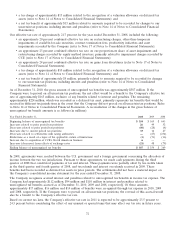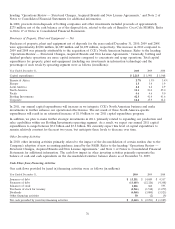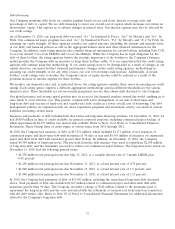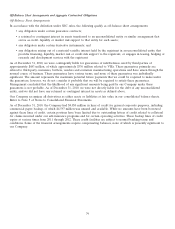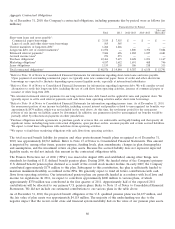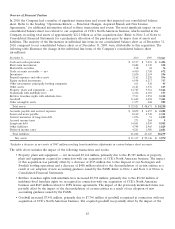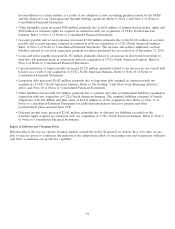Coca Cola 2010 Annual Report Download - page 76
Download and view the complete annual report
Please find page 76 of the 2010 Coca Cola annual report below. You can navigate through the pages in the report by either clicking on the pages listed below, or by using the keyword search tool below to find specific information within the annual report.The Company contributed $77 million to our pension plans during the year ended December 31, 2010. In 2011, we
expect to contribute $800 million to various plans, of which approximately $750 million was contributed in the first
quarter of 2011. Approximately half of the expected 2011 contributions will be allocated to our primary U.S. pension
plans. Refer to Note 13 of Notes to Consolidated Financial Statements.
The government in Venezuela has enacted certain monetary policies that restrict the ability of companies to pay
dividends from retained earnings. As of December 31, 2010, cash held by our Venezuelan subsidiary accounted for
approximately 2 percent of our consolidated cash and cash equivalents balance. In the first quarter of 2010 the
Venezuelan government announced a currency devaluation and Venezuela was determined to be a hyperinflationary
economy. As a result, our local subsidiary was required to use the U.S. dollar as its functional currency, and we
recorded a net remeasurement loss of $103 million during the first quarter of 2010 in the line item other income
(loss) — net in our consolidated statement of income. As of December 31, 2010, our Venezuelan subsidiary held
monetary assets of approximately $200 million.
In addition to the foreign currency exchange exposure related to our Venezuelan subsidiary’s net assets, we also sell
concentrate to our bottling partner in Venezuela from outside the country. These sales are denominated in U.S. dollars.
Some of our concentrate sales were approved by the CADIVI to receive the official rate for essential goods of
2.6 bolivars per U.S. dollar prior to the elimination of the official rate for essential goods in December 2010. Prior to
the elimination of the official rate for essential goods, our bottling partner in Venezuela was able to convert bolivars to
U.S. dollars to settle our receivables related to sales approved by the CADIVI. Therefore, as of December 31, 2010,
our receivable balance related to concentrate sales that had been approved by the CADIVI was not significant. If we
are unable to utilize a government-approved exchange rate mechanism for future concentrate sales to our bottling
partner in Venezuela, the amount of receivables related to these sales will increase.
In addition to the Company’s cash balances and commercial paper program, we also maintain $4,850 million in lines of
credit for general corporate purposes, including commercial paper backup, of which approximately $4,597 million was
unused and available as of December 31, 2010. Refer to Note 10 of Notes to Consolidated Financial Statements. These
backup lines of credit expire at various times from 2011 through 2012. These credit facilities are subject to normal
banking terms and conditions. Some of the financial arrangements require compensating balances, none of which is
presently significant to our Company. We have evaluated the financial stability of each bank and believe we can access
the funds, if needed.
Based on all the aforementioned factors, the Company believes its current liquidity position is strong, and we will
continue to meet all our financial commitments for the foreseeable future.
Cash Flows from Operating Activities
Net cash provided by operating activities for the years ended December 31, 2010, 2009 and 2008 was $9,532 million,
$8,186 million and $7,571 million, respectively.
Cash flows from operating activities increased $1,346 million, or 16 percent, in 2010 compared to 2009. This increase
was primarily attributable to increased receipts from customers, the impact of our acquisition of CCE’s North American
business, the favorable impact of exchange rates on operations and a decrease in contributions to our pension plans.
The impact of these items was partially offset by higher tax payments in 2010. The increase in cash receipts from
customers was primarily due to an increase in net operating revenues. Refer to the heading ‘‘Net Operating Revenues,’’
above. Also, in 2009, cash flows from operating activities included the receipt of a $183 million special dividend from
Coca-Cola Hellenic. The Company contributed approximately $77 million to our pension plans during the year ended
December 31, 2010, compared to $269 million during the year ended December 31, 2009.
Cash flows from operating activities increased $615 million, or 8 percent, in 2009 compared to 2008. This increase was
primarily attributable to lower tax payments, decreased payments to suppliers and vendors, and the receipt of a
$183 million special dividend from Coca-Cola Hellenic. The special dividend received from Coca-Cola Hellenic was
incremental to its normal quarterly dividend. We classified the receipt of this special dividend in cash flows from
operating activities due to the fact that our cumulative equity in earnings from Coca-Cola Hellenic exceeded the
cumulative distributions received; therefore, the special dividend was deemed to be a return on our investment and not
a return of our investment. The impact of these items was partially offset by increased contributions to our pension
plans. The increase in contributions to our pension plans was primarily due to the decline in fair value of our pension
74



